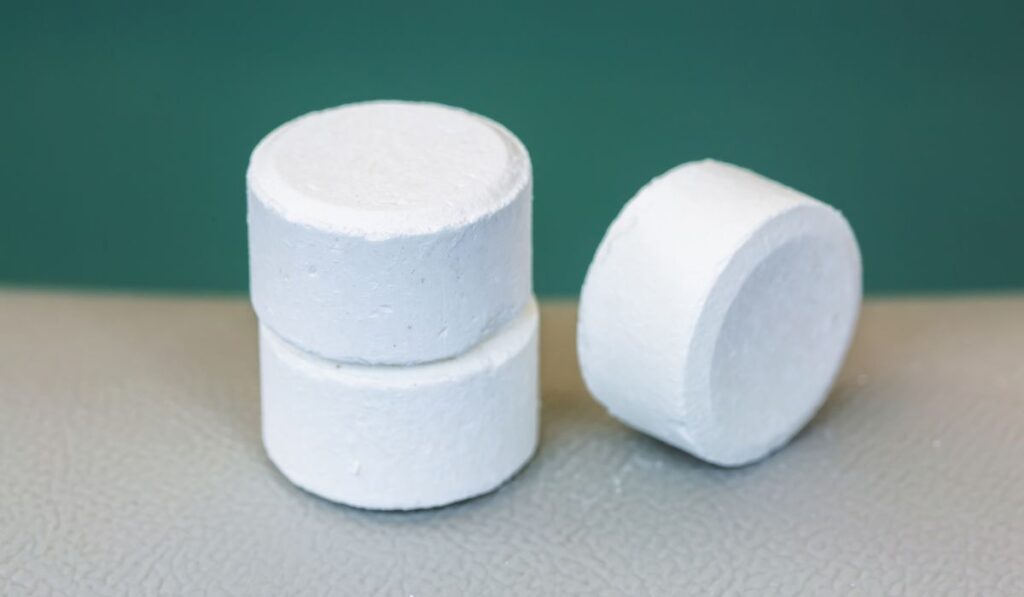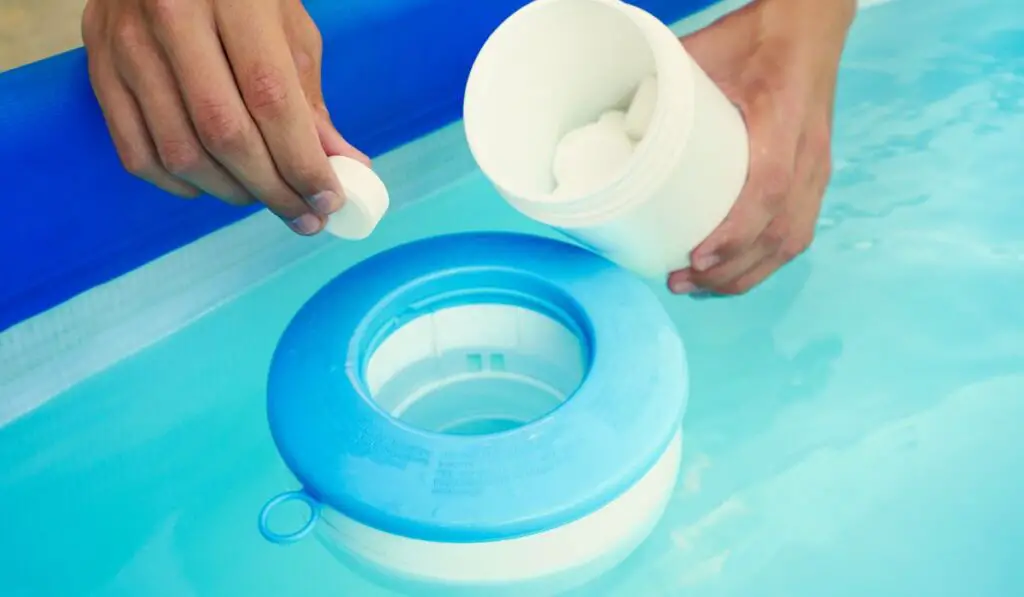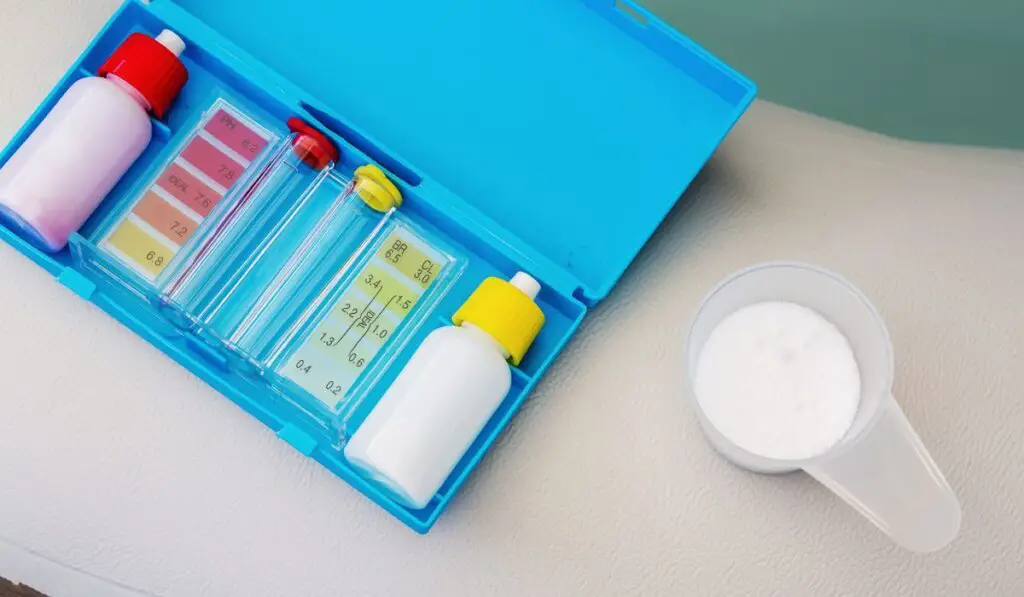Bromine and chlorine are chemical products commonly used for water sanitization, which makes them perfect for hot tubs. But which one should you choose for your hot tub?
Whether you choose chlorine or bromine will depend on your usage, budget, and individual preferences. Both are excellent sanitizers, but they do different jobs. Bromine offers longer-lasting disinfection, ideal for hot water, while chlorine is a stronger disinfectant but is harsher on the skin.
Using the best sanitizers for your hot tub is essential to kill germs and keep your water as clean as possible. Let’s look at the differences between these two chemicals so you can find the one which is best for your hot tub.
Bromine vs Chlorine: What’s the Difference?

Chlorine is the most common choice for swimming pool and hot tub sanitizers. However, bromine is a popular alternative to chlorine for sanitizing water.
Although chlorine effectively kills germs, stops breeding, and makes water fresh and clear, it can sometimes deliver complications. Chlorine can often feel harsh on the skin, causing redness and itching. Plus, it has a high pH, making it more difficult to balance the water and maintain consistency.
If this is the case for you, bromine is a great option to avoid these issues. Bromine is a lot kinder on the skin and has a lower pH, making it easier to use and ensuring your hot tub’s levels stay consistent.
Plus, bromine lasts longer as a disinfectant than chlorine, so it can take some pressure off of the frequency with which you need to add chemicals to your pool. Bromine is also better for high water temperatures as it doesn’t break down as quickly as chlorine. It might be more expensive, but worth it if you desire safer chemicals and easier use.
A key physical difference between chlorine and bromine is the smell. Chlorine is a lot stronger than bromine. Bromine does have a slight bleach-like scent, but it isn’t as harsh on the nose as chlorine. Not to mention Bromine is brown in color, whereas chlorine is a yellow-green color. This notable difference makes them easy to distinguish before adding them to your hot tub.
Is Bromine Or Chlorine Safer?
Many people might prefer to choose the safer sanitization option for their hot tub. If this is you, bromine would be the better choice as its chemical properties are less harmful. Chlorine is known to be toxic if inhaled, and it can be really harsh on the skin.
However, bromine can also be dangerous if used in high quantities. Therefore, it is essential to use it according to the instructions on the bottle.
It is important to be safe when using any type of chemical, especially those used to kill germs, as their properties are strong. Always be cautious and avoid getting the product on your skin, near your eyes, or in your mouth.
Advantages of Chlorine

Although chlorine can deliver issues from time to time, it is mostly safe and popular for anyone wishing to sanitize their hot tub. It does what it says on the label, and works to kill bacteria and stop the spreading of germs.
Below are some advantages of chlorine you will want to know to help you make the right hot tub sanitization choice:
- Easy maintenance help. If you ever need help with your chlorine levels, chlorine is much easier to find information about. All swimming pool and hot tub experts will be clued up on chlorine and ensure efficient recovery if something happens to your water.
- Cheaper. Chlorine is best known for its affordability in sanitization products, like these chlorination pucks for example (on Amazon). It is considerably more affordable than bromine.
- The chemical will not damage garden features. Although chlorine is strong enough to kill germs and bacteria, it won’t damage your pool deck or garden furniture.
Advantages of Bromine
Alike chlorine, bromine has its many advantages, some of which are why hot tub users switch from using chlorine to bromine:
- Kinder to the skin. Bromine is much kinder to the skin than chlorine. It doesn’t dry or irritate the skin, so users can ensure their skin is protected.
- Easier to maintain pH levels. Using bromine makes it easier to maintain your hot tub’s pH levels. Bromine is less exposed to pH fluctuations, so you do not have to retest too often.
- More stable and longer-lasting. Bromine offers more stability as the levels in the water will stay more consistent, even if the temperature increases. As a disinfectant, it is longer lasting than chlorine.
- Effective in hot water. Unlike chlorine, bromine is effective in hot water. It doesn’t dissipate when coming into contact with warm temperatures.
Downsides of Chlorine
For the most part, chlorine offers lots of advantages for hot tub users. It is primarily safe and ensures excellent hygiene for the water.
However, chlorine does have some downsides:
- Chloramine mixing issues. When bacteria-infested water mixes with chlorine, it causes chloramine. Chloramine is what everyone refers to as the chlorine smell. This smell can be frustrating, and chloramine can also cause damage to the eyes and skin.
- Requires frequent testing. Chlorine doesn’t self-regulate effectively. Sometimes you will find the pH levels perfect; other times, you might need to retest before it’s right. Therefore, chlorine can be more time-consuming when you wish to balance your hot tub’s water.
- It can quickly lose effectiveness. The chlorine will lose effectiveness when your pool or hot tub is before 7.8 on the pH scale. Hence, it won’t work to kill germs and keep your water bacteria-free.
Downsides of Bromine
Although bromine is a great product, it does have downsides:
- More expensive. Bromine is more expensive than chlorine, typically 20% more than chlorine. However, you will likely need more chlorine than bromine due to regular retesting and chlorine needing to be easier to balance. Therefore, bromine could work out more cost-effectively overall.
- Slower to kill germs. Bromine is slower to kill germs than chlorine. It is a gentler and milder product, so it doesn’t work as quickly. Yet, when it does take action, it is highly effective at killing germs.
How to Switch From Chlorine to Bromine in Your Hot Tub

Many people consider switching from chlorine to bromine in their hot tub because bromine is kinder on the skin and much easier to maintain. Although chlorine can be cheaper, you might need a higher quantity of it to maintain the hygiene of the hot tub. Therefore, transitioning to bromine could be as cost-effective and better for you overall.
Switching from chlorine to bromine can be easy if you follow these tips.
- First, you will need to empty your hot tub. This will remove any germs, water, and excess chlorine.
- Give your hot tub an efficient rinse and shrub to remove any chlorine residue. Mixing chlorine and bromine creates bromide ions, which can harm the skin and cause adverse hot tub reactions.
- Next, you will need to establish a bromide bank. To do this, you need to add bromide, such as this one (on Amazon), then add water to get the hot tub up to the correct ratio.
- Turning your bromide into bromine is your next task. This is easily achievable by adding shock to your hot tub. Shock works with bromide to convert the chemicals into bromine, an effective chemical to kill germs in your water.
- Once the setup is complete, it is important to use brominators. These dissolvable tablets help maintain your bromide bank so that there is always enough bromine to sanitize your water when you use your hot tub. Some hot tubs can withstand six tablets, but starting with one or two is recommended.
After you have switched from chlorine to bromine, you need to keep up the maintenance to ensure your water is always dissipated from germs and bacteria. Checking your pH levels once a week and maintaining your bromide bank will ensure the best results.
Can You Shock a Bromine Pool?
Yes, you can and must shock a bromine pool. Shocking a bromine pool will help turn bromide chemicals into bromine, which is needed for hot tub sanitization.
You can use bleach as a shock or manufactured tablets. Both work to oxidize and transition bromide into bromine (you can view our hot tub shocking guide here).
Will Bromine Raise Alkalinity?
Bromine has a naturally low pH level of about 4. Using it in your water will slowly reduce your hot tub’s pH levels, which will not raise your alkalinity. Instead, it will reduce it.
If you wish to raise the alkalinity of your hot tub, it is recommended to add a base rather than Bromine to increase the levels. Bromine will have the opposite effect.
Is Chlorine or Bromine Better for Indoor Pools?
Both chlorine and bromine can be used effectively to sanitize indoor pools. Chlorine is the better option for outdoor pools and hot tubs as it offers some protection from UV rays from the sun. Bromine does not have this capability.
So, when it comes to an outdoor pool, chlorine is often the better choice to ensure the water is safe and contaminant-free. For indoor pools, either can be used. However, bromine might be the better option for indoor pools if you wish for gentle chemicals that are easy to maintain and less of that chlorine smell.
